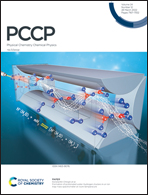What quantum chemical simulations tell us about the infrared spectra, structure and interionic interactions of a bulk ionic liquid†
Abstract
The recently developed efficient protocol to explicit quantum mechanical modeling of the structure and IR spectra of liquids and solutions [Katsyuba et al., J. Phys. Chem. B, 2020, 124, 6664–6670] is applied to ionic liquid 1-ethyl-3-methyl-imidazolium tetrafluoroborate [Emim][BF4], and its C2-deuterated analog [Emim-d][BF4]. It is shown that the solvation strongly modifies the frequencies and IR intensities of both cationic and anionic components of the ionic liquids. The main features of the bulk spectra are reproduced by the simulations for cluster ([Emim][BF4])8, representing an ion pair solvated by the first solvation shell. The geometry of the cluster closely resembles the solid-state structure of the actual ionic liquid and is characterized by short contacts of all CH moieties of the imidazolium ring with [BF4]− anions. Both structural and spectroscopic analyses allow the contacts to be interpreted as hydrogen bonds of approximately equal strength. The enthalpies of these liquid-state H-bonds, estimated with the use of empirical correlations, amount to 1.2–1.5 kcal mol−1, while the analogous estimates obtained for the gas-phase charged species [Emim][BF4]2− and [Emim]2[BF4]+ increase to 3.6–3.9 kcal mol−1.



 Please wait while we load your content...
Please wait while we load your content...